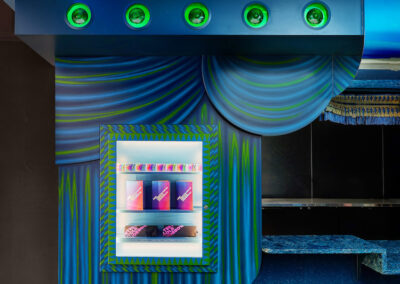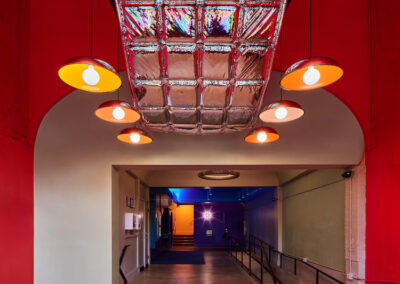One wouldn’t expect the prelude to a screening of David Byrne’s American Utopia to be a conversation—facilitated by the polymath—on affordable housing, but that’s what happened this past November at the Tomorrow Theater in Portland, Oregon. For one hour Byrne, joined by Madeline Kovacs, a housing development manager, and Montana State Representative Danny Tenenbaum, held the attention of the full auditorium as they discussed residential infill, accessory dwelling units and the various pathways Oregon and Montana are taking to tackle the plight occurring in the two states (and across the country).
While Byrne and the housing crises seem like an unlikely pairing, it is exactly this surprise that the Tomorrow Theater is aiming for. As the new East Portland outpost of the Portland Art Museum (PAM), the building is not only a physical expansion but an experimental one too. Occupying the old Oregon Theater which over its 100-year history, has been a theater for many genres (most recently X-rated), the Tomorrow Theater is the home for PAM CUT—the museum’s new media arm called the “Center for an Untold Tomorrow.” As an extension of the CUT, Tomorrow Theater aims to explore new modes of storytelling and to provide experimental programming that is as adaptive as it is creative, embracing mediums from virtual reality to classic film to “social cinema,” in which costumes are encouraged and dance lessons are provided. Its website even has a space to submit your own ideas for future programming.

Interior of the Tomorrow Theater. Courtesy of PAM Cut.
It wasn’t just the public opening of the new venue but also the kickoff for its “Carte Blanche” series, in which artists were invited to take over the space and do what they please. Consider it a short-term residency where creatives can run wild and showcase whatever they’ve been ruminating on. For Byrne, that was to discuss the positive work being done by champions of affordable housing, a subject he’s discussed in his online magazine Reasons to Be Cheerful, and to present his new film to an audience that got up and danced to songs advocating for a rhizomatic form of community. Up next is costume designer Ruth E. Carter, whose accolades include Oscars for Malcolm X and Black Panther.
While the theater has obviously (and thankfully) been deep cleaned and renovated since the adult theater closed its doors in 2020, the revamp by Osmose Design nods to the building’s eccentric history. The yellow hallway is dubbed the “I Am Curious (Yellow)” hall, after the movie that pushed the theater from arthouse to X-rated theater. Suspended from the lobby’s ceiling is a metallic silver sculpture of a mattress—an homage to the former seating (and reclining) arrangements. Richly colored, ruched curtains made by the Portland Garment Factory (one of many artist groups that contributed pieces) adorn the walls of the interior, and repurposed bowls form the lighting in the lobby. The atmosphere, which Director Amy Dotson says was partially inspired by its vaudeville past and Vivienne Westwood, is a far cry from the classic museum design found at the downtown art museum—but that’s just the point: The theater functions almost like a site for the city’s alternative and niche pockets of art to converge and create. It’s a place where one can suspend any expectations of yesterday or today, and instead just let a tomorrow unfurl around.




